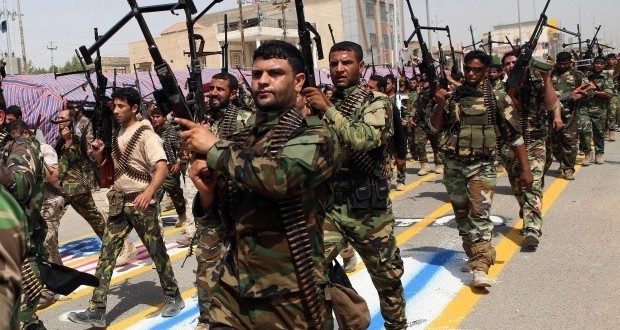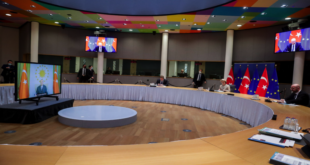Even if ISIS loses Tikrit, they will remain a threat if the Iraqi government and sectarian Shia militias continue to persecute Iraq’s Sunni Arabs. For lasting victory, the Sunnis must be involved.
As the US Chief of Staff, General Martin Dempsey, recently stated, Iraqi government forces and their allied Shia militias are highly likely to retake Tikrit. The operation, now entering its third week, to prise Tikrit out of the clutches of ISIS (or the “Islamic State”, as the group now calls themselves) is clearly part of a larger campaign that aims at recapturing Mosul which, along with Tikrit, was lost to ISIS in a lightning advance last summer.
This may sound like it will be a devastating blow to the terrorist organisation, responsible for numerous atrocities against Iraqis of all creeds and cultures. However, they will not only survive such a territorial loss, but potentially thrive as a result of it. This is particularly likely if the Iraqi government does not rein in its own sectarian policies and restrain the virulently anti-Sunni Shia militias who have become more powerful than the Iraqi Army itself.
According to the CIA, as of September 2014 ISIS has over 30,000 members and counting. This may sound difficult to believe, especially when one considers the massive expanse of territory it controls, stretching from areas in northern and eastern Syria into much of northern and western Iraq. Nonetheless, a sense of the almost inevitable defeat that ISIS will suffer in the coming days and weeks can be gauged from the fact that there are 27,000 Iraqi soldiers and fighters from the Shia al-Hashd al-Sha’bi militia that have converged on Tikrit alone.
These fighters are likely also being directed and commanded by the enigmatic Iranian Revolutionary Guards Corps (IRGC) elite Quds Force commander,General Qassem Soleimani. The usual, almost arbitrary, ratio of recommended manpower in attacking a defending enemy has classically been 3 attackers for every 1 defender. As fierce and proficient as ISIS fighters may be, their force in Tikrit is likely to be vastly under 9,000 men, and thus it is only a matter of time before the city falls.
Winning the battle, losing the war?
Whilst such news ought to be welcomed, this is not a simple story of an Iraqi city being conquered by marauding savages and subsequently being liberated by a valiant force of Iraqi patriots. The collapse of the Iraqi Army and its retreat from Mosul, Tikrit, Fallujah, Garma and many other Sunni towns and cities occurred within the context of a wider Sunni Arab revolt erupting after a peaceful protest movement was brutally suppressed in December 2013 by the government of former Prime Minister, and current Vice President, Nuri al-Maliki.
Maliki, a Shia with known sectarian tendencies, not only refused to heed the exasperated Sunni Arab community’s calls for an end to government abuses and anti-Sunni policies, but also attacked and killed the supporters of Ayatollah al-Sarkhi, a Shia cleric who rejects Iranian religious and political influence over Iraq and who ordered his followers not to join the al-Hasd al-Sha’bi militia, as he deemed it to be a sectarian force. This atmosphere forced many Sunni Arabs to take up arms against the government.
So were the Sunni Arabs in league with ISIS? Not at all. It is a well-known fact that the only force known to have decisively defeated previous iterations and manifestations of ISIS were Iraq’s Sunni Arabs as a part of the Sunni Awakening in 2006-2008. Rather than being lauded as saviours who devastated the so-called Islamic State in Iraq (ISIS’s earlier form), the Sunni Arabs were once more subjected to marginalisation after they had already been smeared as Ba’ath Party loyalists. Maliki’s State of Law coalition, a bloc of Shia political parties, expanded their efforts in side-lining the Sunnis and used such laws such as the Anti-Terrorism Law to hound Iraq’s Sunni Arabs. As part of a report on Iraq a decade after the invasion, Amnesty International reported that this law is so loosely worded that it has been used to arbitrarily arrest and subsequently convict many Sunni Arabs on charges of terrorism.
The Sunni Arabs were backed into a corner, and therefore seemingly made an alliance of convenience with ISIS who suddenly appeared back on the Iraqi stage after being empowered by the crisis in neighbouring Syria. Groups such as theGeneral Military Council for the Iraqi Revolutionaries (GMCIR), a coalition of Sunni Arab tribes who once fought al-Qaeda, were involved in the fall of Tikrit and Mosul, but withdrew from the scene after ISIS intentionally drew international attention in the form of US airstrikes when they threatened Kurdish-controlled Erbil. This is likely because ISIS successfully managed to paint all of the Sunni rebels as being cut from the same cloth, which is far from true. In so doing, they forced the rebels to either fight alongside them and risk airstrikes and demonization, or bow out (which is what they clearly decided to do).
In the meantime, any territory “liberated” from ISIS by Iraqi forces and the sectarian militias thus far has witnessed horrendous atrocities inflicted upon the local Sunni Arabs. After Diyala Province was retaken by the Green Zone government, Sunni Arabs who were fleeing ISIS controlled areas and heading towards what they thought would be the protection of the government weremassacred at Barwana. Iraqi forces even committed mass murders of unarmed, defenceless prisoners when they were withdrawing from cities that they could no longer hold. All of these amount to war crimes, and will continue to feed the hotbed of disenfranchisement, anger, terror and fear of sectarian reprisals that the Iraqi government’s policies have encouraged and that ISIS thrives off.
What is increasingly disturbing is that these acts are not in the distant past, but are very recent and ongoing crimes. In a video aired on Al Jazeera, Hadi al-Amiri, the Iraqi Minister for Transportation and commander of the Badr Brigade Shia militia (somehow, holding a cabinet position and command of a death squad is not considered a conflict of interest in Iraq), threatened an entire Sunni Arab tribe, the Elbu Ajeel, and told them that by not taking up arms against ISIS, they were now considered targets – in other words, they were either “with Iraq, or with terrorism”.
This was echoed by Prime Minister Haidar al-Abadi, long praised as a moderate Shia but who is perhaps now revealing his true colours by saying, “There is no neutrality in the battle against ISIS. If someone is being neutral with ISIS, then he is one of them”. This could be seen as directly criminalising those who wanted to stay out of the fighting, and greenlighting the sectarian Shia militias to take their lives. As it turned out, activists leaked a video showing how al-Amiri made good on his threat, and burned Elbu Ajeel to the ground.
Perpetuating violence
If the Iraqi government retakes Tikrit and repeats these actions on a larger scale, it may force all neutral Sunni Arabs to fight alongside ISIS if only to protect themselves, their families and their property from the sectarian Shia militias that al-Abadi promised to ban, but instead allowed to thrive. Such sectarianism will not defeat ISIS, but will instead empower them, feed them and allow them to grow if the Sunni tribes act as auxiliary forces for them. ISIS will be legitimised and not weakened by Shia militias preying on Sunni Arab civilians, able to claim that they are the only group willing and capable of protecting the Sunnis. Such war crimes and atrocities will also further accelerate a perhaps irreversible division of Iraq along sectarian lines, and ensure violence will continue for generations to come.
The views expressed in this article are the author’s own and do not necessarily represent those of ForMENA.
 ForMENA Council for MENA affairs
ForMENA Council for MENA affairs




